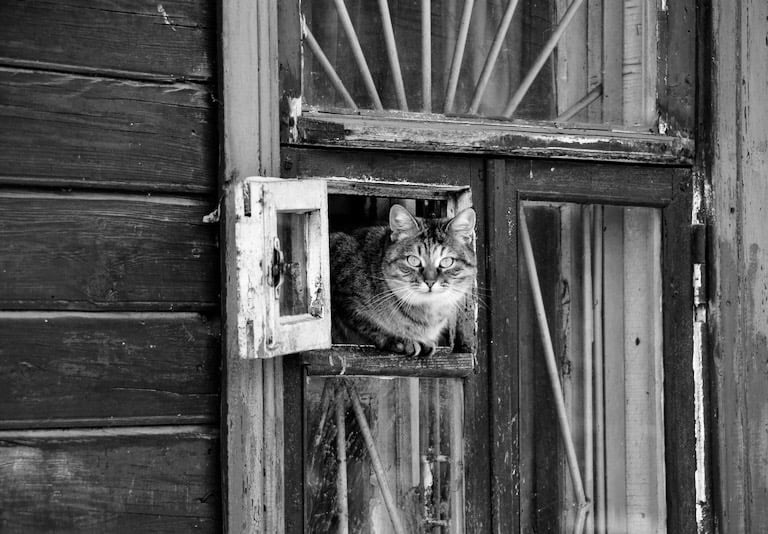Moments in Motion 動きの瞬間
Taro Suzuki's Tokyo Tales
PHOTOGRAPHY PERSPECTIVES


In the neon-lit heart of Tokyo, where the city pulsates with endless energy, Taro Suzuki, a retired street photographer, captures life’s quieter, more candid moments. From his early days as a passionate young photographer to his golden years, Taro has seen Tokyo through many lenses, but none more favoured than his trusty Leica M6. This camera, a relic from his youth, mirrors the timeless essence of his subjects—mostly the city’s cats and dogs, whose unaffected nature provides genuine snapshots of urban life.
Every morning, Taro Suzuki greets the day with a ritual that centres his mind and prepares him for his photographic pursuits. His day begins at a humble neighbourhood café, a place where the aroma of freshly brewed coffee mingles with the sweetness of pastries. Here, he prefers a quieter start: a cup of steaming green tea, which he sips thoughtfully, paired with a dorayaki—those delightful honey-filled pancakes that offer a taste of traditional Japanese sweetness. This simple meal, consumed slowly, allows Taro time to contemplate his route for the day.
With the sun just starting to ascend, Taro steps out into the lively streets of Shimokitazawa and Koenji, areas famed not just for their vintage shops and indie music scene, but also for their vibrant street life that provides endless inspiration for a photographer like him. These neighbourhoods, with their narrow alleys and eclectic mix of old and new, are where Taro feels most at home. He meanders through these streets, his Leica M6 always ready at his side, capturing the dance of light and shadows as the day unfolds.
Stray cats, basking in the morning sun, often catch his eye. These serene creatures, with their unbothered demeanour, make perfect subjects. They are stark contrasts to the bustling human activity around them—shopkeepers setting out their wares, early shoppers browsing through morning markets, and children on their way to school. Taro delights in these contrasts, finding beauty in the serenity of the animals amidst the human chaos.
His pursuit of the perfect shot is methodical yet instinctive. He watches how morning light casts long shadows and how it illuminates faces and storefronts, creating a canvas ripe for photography. Taro’s approach is that of a hunter tracking subtle cues— a glance, a gesture, a fleeting expression.
By mid-morning, Taro usually finds himself deep in the residential pockets of the neighbourhoods, where the true essence of Tokyo's daily life plays out away from the main thoroughfares. Here, he often pauses, engaging with the locals, sometimes even showing them his photographs, which often elicits smiles and nods of recognition. It's a meaningful exchange for Taro, as it deepens his connection to the subjects and places he photographs.
By lunchtime, Taro Suzuki's steps inevitably lead him to the warm, inviting embrace of "Ramen Yokocho," a quaint ramen shop nestled in the heart of Shibuya. Known affectionately to locals and the shop's affable owner, Hiro, as "Suzuki-san," Taro is a fixture at his favourite corner table.
On these occasions, he's often joined by a close-knit group of fellow photography aficionados: Kenji, an old schoolmate and a fellow Leica enthusiast; Aiko, a recent art school graduate with a fresh perspective on digital photography; and Satoshi, a retired journalist with a wealth of stories from his days on the field. The table buzzes with animated conversation, steam rising from the large bowls of ramen in front of them.
Today, as Hiro sets down Taro's usual order—a steaming bowl of miso ramen topped with a perfectly soft-boiled egg—the conversation turns to the merits of various film types. Kenji, ever the traditionalist, argues for the classic Ilford HP5 for its grain and contrast, while Aiko speaks fervently about the flexibility of Kodak Portra, ideal for her colour street portraits.
Taro listens intently, sharing stories and insights gained from decades of shooting with his trusty Leica M6. His experiences bridge the rich history of film photography and the new digital techniques that Aiko brings to the table. It’s during these gatherings that Taro’s philosophy truly comes to life: he believes in capturing the essence of moments, focusing on the raw and real rather than the polished and edited.
These lunches at Ramen Yokocho are more than just meals; they are Taro’s connection to his past and his gateway to the evolving world of photography. As the lunch hour wanes, the group reluctantly parts ways, inspired and eager to explore the streets once more with fresh eyes and, perhaps, old cameras.
As dusk falls, Taro returns to his modest home, where he has set up a small darkroom. Here, he develops his film, a process he cherishes for its hands-on nature and the direct connection it provides to his craft. After developing, he carefully scans the negatives, transforming these analog memories into digital files. This method allows him to share and preserve his work while maintaining the photograph’s original integrity. His post-processing is deliberately minimal, focused solely on removing any imperfections like dust spots and making slight adjustments to ensure the black and white contrasts speak as vividly as the scenes he witnessed.
Taro’s approach to photography is holistic. He believes that the true artistry of photography lies not in manipulation but in the authentic representation of life. His days, filled with exploration and engagement, reflect a deep commitment to the art form—continually learning, adapting, and embracing the ever-changing tapestry of Tokyo.
In every frame, Taro captures not just images but stories, each photograph a testament to the life unfolding before him. Taro Suzuki, with his camera and his city, continues to be a chronicler of the myriad faces of Tokyo, a storyteller who communicates in the silent, eloquent language of light and shadow. Through his lens, he not only observes the world but also invites others to see the beauty in the everyday, the ordinary, and the overlooked.
© Peter Pickering 2024. www.peterpickering.com
東京のネオンで照らされた心臓部で、街が絶え間ないエネルギーで脈打っている中、鈴木太郎という退職したストリートフォトグラファーが、人生の静かで率直な瞬間を捉えています。情熱的な若き写真家としての初期から黄金年まで、太郎は多くのレンズを通じて東京を見てきましたが、特に信頼しているのは彼の古いライカM6です。このカメラは、彼の被写体の普遍的な本質を反映しており、特に街の猫や犬など、その気取らない性質が都市生活の真正なスナップショットを提供します。
毎朝、鈴木太郎は一日の始まりを迎える儀式で心を中心に据え、写真撮影の準備をします。彼の一日は、地元の質素なカフェで始まります。ここでは新鮮に淹れたコーヒーの香りとペストリーの甘さが混ざり合っています。彼はここで静かにスタートを切ることを好み、思慮深く緑茶をすすりながら、どら焼き(伝統的な日本の甘味の一つで、蜂蜜を填めたパンケーキ)を楽しむことが多いです。このシンプルな食事をゆっくりと消費することで、太郎はその日のルートをじっくりと考える時間を持てます。
太陽が昇り始めると、太郎は下北沢や高円寺といった、ヴィンテージショップやインディーミュージックシーンで知られる地域の活気に満ちた街路へと歩を進めます。これらの地域は、その狭い路地と古くから新しいものが混在する個性的な雰囲気で、太郎にとって最も居心地の良い場所です。彼はこれらの街を歩きながら、いつもそばに携えたライカM6で、一日が織りなす光と影のダンスを捉えます。
朝日を浴びてくつろぐ野良猫たちがよく彼の目を引きます。これらの穏やかな生き物は、その動じない様子で完璧な被写体となります。これらは、商品を並べる店主、朝の市場をブラウズする初期の買い物客、学校へ向かう子供たちといった、周囲の忙しい人間活動とは鮮やかな対照をなしています。太郎はこれらの対照を楽しみ、人間の混沌とした中で動物の静けさに美を見出します。
完璧なショットを追求する彼の方法は、方法的でありながらも本能的です。彼は朝の光がどのように長い影を落とし、どのように顔や店先を照らすかを観察し、写真撮影に適したキャンバスを作り出します。太郎のアプローチは、狩猟者が微妙な手がかり—一瞥、一挙手、一投足を追跡するかのようです。
午前中が進むにつれて、太郎は通常、地元の人々が日常生活を送る街の住宅地の奥深くに自分を見つけます。ここでは、彼はしばしば立ち止まり、地元の人々と交流し、時には彼の写真を見せて彼らの笑顔やうなずきを引き出します。これは太郎にとって意味のある交換であり、彼が撮影する対象や場所とのつながりを深めます。
昼食時には、太郎鈴木の足は必然的に「ラーメン横丁」という温かくて魅力的なラーメン店へと向かいます。この店は渋谷の中心部にひっそりとたたずんでいます。地元の人々や店の好々爺であるヒロには「鈴木さん」と親しみを込めて呼ばれています。太郎はいつもの角のテーブルに座る常連です。
この場では、彼はしばしば、同じくライカ愛好家である旧友の健司や、デジタル写真に新しい視点を持つ芸術学校の最近の卒業生であるアイコ、野外での日々から豊富な話を持つ引退したジャーナリストの聡といった、写真愛好家の親しいグループに加わります。テーブルは活気に満ちた会話で湧いており、目の前の大きなラーメンの丼からは湯気が立ちのぼります。
今日、ヒロが太郎のいつもの注文である完璧な半熟卵ののった味噌ラーメンを置くと、会話はさまざまなフィルムタイプの長所に移ります。伝統主義者である健司は、その粒子とコントラストのために古典的なIlford HP5を支持する一方で、アイコは彼女のカラーストリートポートレートに理想的なKodak Portraの柔軟性について熱心に語ります。
太郎は熱心に耳を傾け、信頼できるライカM6で撮影した数十年の経験から得た話や洞察を共有します。彼の経験は、フィルム写真の豊かな歴史とアイコが持ち込む新しいデジタル技術とをつなぐものです。これらの集まりの間に、太郎の哲学が真に生きるのです。彼は、磨かれたものではなく生のリアルに焦点を当て、瞬間の本質を捉えることを信じています。
「ラーメン横丁」でのこれらのランチは単なる食事以上のものです。それらは太郎が過去とつながり、写真の進化する世界への入り口となっています。昼食時間が終わるにつれ、グループはしぶしぶ別れ、新たな目で、そしてお昔のカメラで再び通りを探索することを楽しみにしています。
日が暮れるにつれて、太郎は彼の控えめな家に戻ります。そこには彼が設けた小さな暗室があります。ここで彼はフィルムを現像するプロセスを大切に行います。この手作業の性質と彼の技術への直接的なつながりは、彼にとって非常に価値のあるものです。現像後、彼は慎重にネガをスキャンし、これらのアナログの記憶をデジタルファイルに変換します。この方法により、彼は作品を共有し保存することができ、写真のオリジナルの完整性を保ちながらです。彼のポストプロセスは意図的に最小限に抑えられており、ほこりの斑点を取り除くこと、そして白黒のコントラストが彼が目撃したシーンと同じくらい生き生きと語るように、わずかな調整をすることにのみ焦点を当てています。
太郎の写真へのアプローチは全体的です。彼は、写真の真の芸術性は操作にあるのではなく、生活の本物の表現にあると信じています。彼の日々は、探求と関与で満たされており、形を変え続ける東京のタペストリーを抱擁するアートフォームへの深いコミットメントを反映しています。
太郎は、各写真でただの画像だけでなく物語を捉えています。それぞれの写真は、彼の前で繰り広げられる生活の証となっています。カメラと彼の街を持つ鈴木太郎は、東京の無数の顔の記録者であり続け、光と影の沈黙の雄弁な言語でコミュニケーションを取る物語家です。彼のレンズを通して、彼は世界をただ観察するだけでなく、他の人々に日常の、ありふれた、見過ごされがちな美しさを見るよう招待しています。
© Peter Pickering 2024. www.peterpickering.com




